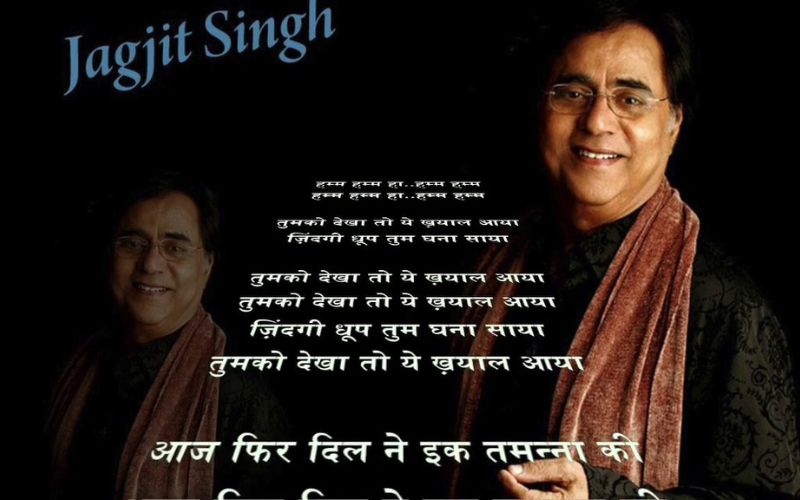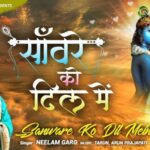Jagjit Singh, the legendary Indian ghazal singer, composer, and musician, has left an indelible mark on the world of music. Known for his soulful renditions and captivating performances, Jagjit Singh’s impact on the industry is unparalleled. His ability to weave intricate melodies and poignant lyrics has earned him the title of the “Ghazal King” and cemented his place as one of the most revered artists of our time.
In this article, we will delve into the lyrics and significance of one of Jagjit Singh’s most beloved compositions, “Tum Ko Dekha To Yeh Khayal Aaya.” This iconic song has not only captured the hearts of music enthusiasts but has also become a timeless classic, transcending generations and cultures.
Overview of “Tum Ko Dekha To Yeh Khayal Aaya”
“Tum Ko Dekha To Yeh Khayal Aaya” is a ghazal that has become synonymous with Jagjit Singh’s musical legacy. The song was originally composed and performed by the maestro, and its haunting melodies and poetic lyrics have resonated with audiences worldwide.
The ghazal, which translates to “When I Saw You, This Thought Came to Me,” is a profound exploration of love, longing, and the profound impact that a single moment can have on the human heart and soul. The lyrics, penned by the renowned Urdu poet Mirza Ghalib, are a testament to the power of words and their ability to capture the essence of human emotions.
Meaning and Interpretation of the Lyrics
The lyrics of “Tum Ko Dekha To Yeh Khayal Aaya” are a masterful blend of metaphor and introspection, inviting the listener to delve deeper into the complexities of love and the human experience.
The opening lines, “Tum ko dekha to yeh khayal aaya, ki jiya jale, jaan jale” (When I saw you, this thought came to me, that my heart and soul are in pain), set the stage for a journey of self-discovery and emotional turmoil. The poet, through Jagjit Singh’s soulful rendition, conveys the overwhelming sense of longing and the profound impact that a single encounter can have on the human psyche.
As the song progresses, the lyrics delve into the nuances of love and the eternal struggle between the heart and the mind. Lines like “Dil mera toda, mujhe awaaz di, tere pyaar ne pareshaan kiya” (My heart was broken, you called out to me, your love has distressed me) and “Tujhe kitna pyaar karte hain, hum yeh bata nahin sakte” (How much we love you, we cannot express) capture the bittersweet nature of love and the inability to fully convey the depth of one’s emotions.
Popular Renditions of the Song
“Tum Ko Dekha To Yeh Khayal Aaya” has been covered by numerous artists over the years, each offering a unique interpretation of the timeless classic. However, it is Jagjit Singh’s original rendition that remains the most beloved and iconic version of the song.
Jagjit Singh’s haunting vocals, accompanied by his masterful guitar work, have become the definitive interpretation of the ghazal. His ability to infuse the lyrics with raw emotion and profound introspection has earned him widespread acclaim and cemented his status as the true master of the genre.
Other notable renditions of the song include those by Pankaj Udhas, Talat Aziz, and Hariharan, each bringing their own distinct style and interpretation to the beloved composition.
Impact and Legacy of the Song
“Tum Ko Dekha To Yeh Khayal Aaya” has become a cultural touchstone, transcending the boundaries of music and becoming a symbol of the enduring power of art and expression. The song’s ability to resonate with audiences across generations and cultures is a testament to the universality of human emotions and the timeless nature of Jagjit Singh’s artistry.
The song’s impact can be seen in its widespread popularity, with countless covers, remixes, and adaptations created by musicians and artists around the world. It has also been featured in numerous films, television shows, and other media, further cementing its place in the cultural zeitgeist.
Beyond its artistic significance, “Tum Ko Dekha To Yeh Khayal Aaya” has also become a source of inspiration for those seeking to explore the depths of human emotion and the transformative power of music. The song’s enduring legacy continues to inspire and captivate audiences, ensuring that Jagjit Singh’s musical genius will live on for generations to come.
Analysis of the Song’s Composition and Musical Elements
At the heart of “Tum Ko Dekha To Yeh Khayal Aaya” lies a masterful composition that seamlessly blends the traditional elements of the ghazal genre with Jagjit Singh’s unique musical sensibilities.
The song’s melodic structure is built upon a haunting, yet captivating, progression that perfectly complements the poetic lyrics. Jagjit Singh’s use of intricate rhythmic patterns and subtle variations in tempo and dynamics add depth and emotional resonance to the performance, drawing the listener deeper into the song’s introspective nature.
The accompanying instrumentation, which features Jagjit Singh’s signature guitar work, further enhances the song’s atmospheric quality. The delicate interplay between the vocals and the guitar creates a sense of intimacy and vulnerability, allowing the listener to fully immerse themselves in the emotional journey of the lyrics.
Jagjit Singh’s mastery of vocal technique is also on full display in “Tum Ko Dekha To Yeh Khayal Aaya.” His ability to modulate his voice, seamlessly transitioning between powerful and introspective passages, is a testament to his exceptional control and understanding of the human voice as an instrument.
Notable Performances of “Tum Ko Dekha To Yeh Khayal Aaya”
Throughout his illustrious career, Jagjit Singh has delivered countless memorable performances of “Tum Ko Dekha To Yeh Khayal Aaya,” each one leaving an indelible mark on the hearts and minds of his audience.
One particularly notable performance was at the Wembley Arena in London, where Jagjit Singh captivated a packed audience with his soulful rendition of the ghazal. The concert, which was recorded and later released as a live album, showcased the maestro’s ability to command the stage and connect with his listeners on a profound level.
Another iconic performance took place at the Shanmukhananda Hall in Mumbai, where Jagjit Singh’s performance of “Tum Ko Dekha To Yeh Khayal Aaya” was met with thunderous applause and a standing ovation. The audience, enraptured by the singer’s emotional delivery and technical prowess, bore witness to a truly transcendent moment in the history of Indian music.
These performances, and countless others, have cemented Jagjit Singh’s legacy as one of the greatest ghazal singers of all time, and have solidified “Tum Ko Dekha To Yeh Khayal Aaya” as a timeless masterpiece that continues to captivate and inspire music lovers around the world.
Translating the Lyrics into English
For those unfamiliar with the Urdu language, the lyrics of “Tum Ko Dekha To Yeh Khayal Aaya” can be a profound and moving experience when translated into English. The poetic beauty of the original verses is preserved, while the depth of emotion and introspection is made accessible to a wider audience.
The opening lines, “Tum ko dekha to yeh khayal aaya, ki jiya jale, jaan jale” (When I saw you, this thought came to me, that my heart and soul are in pain), convey the overwhelming sense of longing and the profound impact that a single encounter can have on the human psyche.
As the song progresses, the lyrics delve deeper into the complexities of love and the eternal struggle between the heart and the mind. “Dil mera toda, mujhe awaaz di, tere pyaar ne pareshaan kiya” (My heart was broken, you called out to me, your love has distressed me) and “Tujhe kitna pyaar karte hain, hum yeh bata nahin sakte” (How much we love you, we cannot express) capture the bittersweet nature of love and the inability to fully convey the depth of one’s emotions.
By translating the lyrics into English, the universal themes of “Tum Ko Dekha To Yeh Khayal Aaya” become more accessible to a global audience, allowing them to connect with the song’s emotional resonance and Jagjit Singh’s enduring artistic legacy.
Appreciating Jagjit Singh’s Contribution to the Music Industry
Jagjit Singh’s impact on the music industry is truly remarkable, and his contribution to the art of ghazal singing is unparalleled. Through his soulful renditions and innovative approach to the genre, he has inspired generations of musicians and music enthusiasts alike.
Beyond his technical prowess and artistic brilliance, Jagjit Singh’s legacy is defined by his unwavering commitment to the emotional and introspective aspects of music. His ability to capture the complexities of human emotion and to convey them through his performances is a testament to his profound understanding of the human condition.
Through timeless compositions like “Tum Ko Dekha To Yeh Khayal Aaya,” Jagjit Singh has left an indelible mark on the cultural landscape, transcending the boundaries of music and becoming a symbol of the enduring power of artistic expression. His music can touch the hearts and souls of listeners, regardless of their cultural or linguistic backgrounds, and has earned him a place among the most revered artists of our time.
As we continue to appreciate and celebrate the legacy of Jagjit Singh, we are reminded of the transformative power of music and the enduring impact that a single artist can have on the world. Through his music, Jagjit Singh has not only enriched our lives but has also inspired us to seek deeper connections with our own emotions and the human experience.
Conclusion
In the timeless masterpiece “Tum Ko Dekha To Yeh Khayal Aaya,” Jagjit Singh has left an indelible mark on the world of music. This iconic ghazal, with its haunting melodies and poignant lyrics, has captivated audiences across generations and cultures, solidifying Jagjit Singh’s legacy as one of the greatest artists of our time.
Through his soulful renditions and profound understanding of the human experience, Jagjit Singh has not only entertained but also inspired countless individuals to explore the depths of their own emotions and the transformative power of art. As we continue to bask in the glory of his musical genius, we are reminded of the enduring impact that a single artist can have on the world, and the enduring legacy that they leave behind.
If you’re as captivated by Jagjit Singh’s music as we are, we encourage you to explore more of his timeless compositions. Visit our website to discover the full breadth of his artistry and to immerse yourself in the rich tapestry of Indian music. Let Jagjit Singh’s legacy inspire you to embrace the power of music and to connect with the universal human experience.



